- CBSE Class 10 Study Material

CBSE Class 10 Maths Case Study Questions for Maths Chapter 5 - Arithmetic Progression (Published by CBSE)
Case study questions on cbse class 10 maths chapter 5 - arithmetic progression are provided here. these questions are published by cbse to help students prepare for their maths exam..

CBSE Class 10 Case Study Questions for Maths Chapter 5 - Arithmetic Progression are available here with answers. All the questions have been published by the CBSE board. Students must practice all these questions to prepare themselves for attempting the case study based questions with absolute correctness and obtain a high score in their Maths Exam 2021-22.
Case Study Questions for Class 10 Maths Chapter 5 - Arithmetic Progression
CASE STUDY 1:
India is competitive manufacturing location due to the low cost of manpower and strong technical and engineering capabilities contributing to higher quality production runs. The production of TV sets in a factory increases uniformly by a fixed number every year. It produced 16000 sets in 6th year and 22600 in 9th year.

Based on the above information, answer the following questions:
1. Find the production during first year.
2. Find the production during 8th year.
3. Find the production during first 3 years.
4. In which year, the production is Rs 29,200.
5. Find the difference of the production during 7th year and 4th year.
2. Production during 8th year is (a+7d) = 5000 + 2(2200) = 20400
3. Production during first 3 year = 5000 + 7200 + 9400 = 21600
4. N = 12 5.
Difference = 18200 - 11600 = 6600
CASE STUDY 2:
Your friend Veer wants to participate in a 200m race. He can currently run that distance in 51 seconds and with each day of practice it takes him 2 seconds less. He wants to do in 31 seconds.
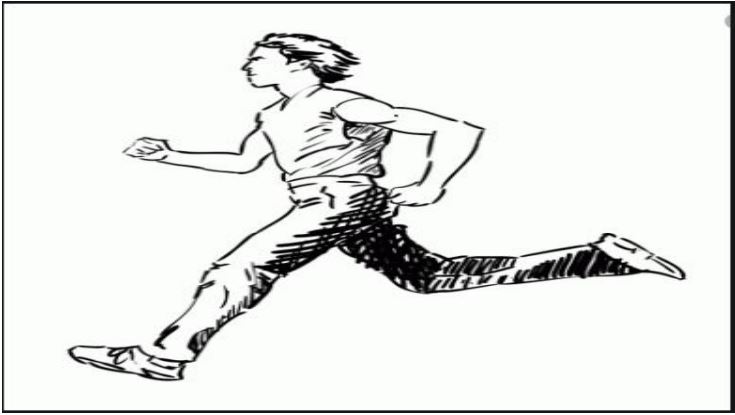
1. Which of the following terms are in AP for the given situation
a) 51,53,55….
b) 51, 49, 47….
c) -51, -53, -55….
d) 51, 55, 59…
Answer: b) 51, 49, 47….
2. What is the minimum number of days he needs to practice till his goal is achieved
Answer: c) 11
3. Which of the following term is not in the AP of the above given situation
Answer: b) 30
4. If nth term of an AP is given by an = 2n + 3 then common difference of an AP is
Answer: a) 2
5. The value of x, for which 2x, x+ 10, 3x + 2 are three consecutive terms of an AP
Answer: a) 6
CASE STUDY 3:
Your elder brother wants to buy a car and plans to take loan from a bank for his car. He repays his total loan of Rs 1,18,000 by paying every month starting with the first instalment of Rs 1000. If he increases the instalment by Rs 100 every month , answer the following:

1. The amount paid by him in 30th installment is
Answer: a) 3900
2. The amount paid by him in the 30 installments is
Answer: b) 73500
3. What amount does he still have to pay offer 30th installment?
Answer: c) 44500
4. If total installments are 40 then amount paid in the last installment?
Answer: a) 4900
5. The ratio of the 1st installment to the last installment is
Answer: b) 10:49
Also Check:
CBSE Case Study Questions for Class 10 Maths - All Chapters
Tips to Solve Case Study Based Questions Accurately
Get here latest School , CBSE and Govt Jobs notification and articles in English and Hindi for Sarkari Naukari , Sarkari Result and Exam Preparation . Download the Jagran Josh Sarkari Naukri App .
- TSPSC Group 1 Hall Ticket 2024
- IBPS PO Admit Card 2024
- ADRE Grade 4 Admit Card 2024
- ITBP Constable Recruitment 2024
- PM Internship Scheme 2024
- MUHS Result 2024
- MJPRU Result 2024
- Moon Timing Today
- CBSE Class 10 Sample Paper 2024-25
- CBSE Class 12 Sample Papers 2024-25
- Education News
- CBSE Study Material
- CBSE Class 10
Latest Education News
List of Femina Miss India winners (1947-2024)
From New Moon to Full Moon: Understanding the 8 Moon Phases
Maharishi Valmiki Jayanti 2024: 25+ Quotes, Wishes to Share for Poet and Author of Ramayana
Picture Puzzle IQ Test: Find the mistake in the picture in 5 seconds!
Brain Teaser: Only High IQs Above 130 Will See the 4 Errors in This Puzzle—Can You Do It in 7 Seconds?
SSC CHSL Marks 2024 OUT: एसएससी सीएचएसएल फाइनल आंसर की जारी, यहां देखें मार्क्स पीडीएफ
AIIMS NORCET 7 Final Result 2024 OUT at aiimsexams.ac.in: Download Link Here
Sharad Purnima 2024: Check Today’s Moonrise Time and Goddess Laxmi Mantra for Students
NTA UGC NET Result 2024 LIVE: बड़ी अपडेट! यूजीसी नेट जून परीक्षा रिजल्ट लिंक ugcnet.nta.ac.in पर जल्द, जानें कहां मिलेगा स्कोरकार्ड
Good News For Farmers: Union Cabinet Increases MSP for Rabi Crops Before Diwali
Spot 3 differences between the deer pictures in 23 seconds
DTU Gears Up for Yuvaan 2024: A Cultural Extravaganza
Sharad Purnima 2024: क्या है चंद्रोदय का समय और छात्रों के लिए क्या है मां लक्ष्मी का उपासना मंत्र, यहां जानें
UPPSC Exam Date 2024: Prelims Exam Postponed Check Official Notice Here
ट्रेन का टिकट खोने या फटने पर क्या करें, यहां पढ़ें
AP LAWCET 2024 Counselling Registration Begins at cets.apsche.ap.gov.in Check Steps to Apply
दिवाली-छठ से पहले यूपी-बिहार की ये ट्रेनें हुई रद्द, 64 के बदले रूट, देखें पूरी लिस्ट
SSC CHSL Marks 2024 Out at ssc.gov.in: Download Final Answer Key and Result Here
List of Important GK Topics for Railways Exams for RRB NTPC, ALP, Technician, JE: Check Subject Wise Topics
Nayab Singh Saini Biography in Hindi: उम्र, परिवार, शिक्षा और करियर, यहां पढ़ें

- Andhra Pradesh
- Chhattisgarh
- West Bengal
- Madhya Pradesh
- Maharashtra
- Jammu & Kashmir
- NCERT Books 2022-23
- NCERT Solutions
- NCERT Notes
- NCERT Exemplar Books
- NCERT Exemplar Solution
- States UT Book
- School Kits & Lab Manual
- NCERT Books 2021-22
- NCERT Books 2020-21
- NCERT Book 2019-2020
- NCERT Book 2015-2016
- RD Sharma Solution
- TS Grewal Solution
- TR Jain Solution
- Selina Solution
- Frank Solution
- Lakhmir Singh and Manjit Kaur Solution
- I.E.Irodov solutions
- ICSE - Goyal Brothers Park
- ICSE - Dorothy M. Noronhe
- Micheal Vaz Solution
- S.S. Krotov Solution
- Evergreen Science
- KC Sinha Solution
- ICSE - ISC Jayanti Sengupta, Oxford
- ICSE Focus on History
- ICSE GeoGraphy Voyage
- ICSE Hindi Solution
- ICSE Treasure Trove Solution
- Thomas & Finney Solution
- SL Loney Solution
- SB Mathur Solution
- P Bahadur Solution
- Narendra Awasthi Solution
- MS Chauhan Solution
- LA Sena Solution
- Integral Calculus Amit Agarwal Solution
- IA Maron Solution
- Hall & Knight Solution
- Errorless Solution
- Pradeep's KL Gogia Solution
- OP Tandon Solutions
- Sample Papers
- Previous Year Question Paper
- Important Question
- Value Based Questions
- CBSE Syllabus
- CBSE MCQs PDF
- Assertion & Reason
- New Revision Notes
- Revision Notes
- Question Bank
- Marks Wise Question
- Toppers Answer Sheets
- Exam Paper Aalysis
- Concept Map
- CBSE Text Book
- Additional Practice Questions
- Vocational Book
- CBSE - Concept
- KVS NCERT CBSE Worksheets
- Formula Class Wise
- Formula Chapter Wise
- Toppers Notes
- Most Repeated Question
- Diagram Based Question
- Study Planner
- JEE Previous Year Paper
- JEE Mock Test
- JEE Crash Course
- JEE Sample Papers
- Important Info
- SRM-JEEE Previous Year Paper
- SRM-JEEE Mock Test
- VITEEE Previous Year Paper
- VITEEE Mock Test
- BITSAT Previous Year Paper
- BITSAT Mock Test
- Manipal Previous Year Paper
- Manipal Engineering Mock Test
- AP EAMCET Previous Year Paper
- AP EAMCET Mock Test
- COMEDK Previous Year Paper
- COMEDK Mock Test
- GUJCET Previous Year Paper
- GUJCET Mock Test
- KCET Previous Year Paper
- KCET Mock Test
- KEAM Previous Year Paper
- KEAM Mock Test
- MHT CET Previous Year Paper
- MHT CET Mock Test
- TS EAMCET Previous Year Paper
- TS EAMCET Mock Test
- WBJEE Previous Year Paper
- WBJEE Mock Test
- AMU Previous Year Paper
- AMU Mock Test
- CUSAT Previous Year Paper
- CUSAT Mock Test
- AEEE Previous Year Paper
- AEEE Mock Test
- UPSEE Previous Year Paper
- UPSEE Mock Test
- CGPET Previous Year Paper
- BCECE Previous Year Paper
- JCECE Previous Year Paper
- Crash Course
- Previous Year Paper
- NCERT Based Short Notes
- NCERT Based Tests
- NEET Sample Paper
- Previous Year Papers
- Quantitative Aptitude
- Numerical Aptitude Data Interpretation
- General Knowledge
- Mathematics
- Agriculture
- Accountancy
- Business Studies
- Political science
- Enviromental Studies
- Mass Media Communication
- Teaching Aptitude
- Verbal Ability & Reading Comprehension
- Logical Reasoning & Data Interpretation
- CAT Mock Test
- CAT Important Question
- CAT Vocabulary
- CAT English Grammar
- MBA General Knowledge
- CAT Mind Map
- CAT Study Planner
- CMAT Mock Test
- SRCC GBO Mock Test
- SRCC GBO PYQs
- XAT Mock Test
- SNAP Mock Test
- IIFT Mock Test
- MAT Mock Test
- CUET PG Mock Test
- CUET PG PYQs
- MAH CET Mock Test
- MAH CET PYQs
- NAVODAYA VIDYALAYA
- SAINIK SCHOOL (AISSEE)
- Mechanical Engineering
- Electrical Engineering
- Electronics & Communication Engineering
- Civil Engineering
- Computer Science Engineering
- CBSE Board News
- Scholarship Olympiad
- School Admissions
- Entrance Exams
- All Board Updates
- Miscellaneous
- State Wise Books
- Engineering Exam
- STATE WISE BOOKS
- ENGINEERING EXAM
- SCHOLARSHIP OLYMPIAD
- STATE BOOKS
CBSE Class 10 Maths Case Study
CBSE Board has introduced the case study questions for the ongoing academic session 2021-22. The board will ask the paper on the basis of a different exam pattern which has been introduced this year where 50% syllabus is occupied for MCQ for Term 1 exam. Selfstudys has provided below the chapter-wise questions for CBSE Class 10 Maths. Students must solve these case study based problems as soon as they are done with their syllabus.
These case studies are in the form of Multiple Choice Questions where students need to answer them as asked in the exam. The MCQs are not that difficult but having a deep and thorough understanding of NCERT Maths textbooks are required to answer these. Furthermore, we have provided the PDF File of CBSE Class 10 maths case study 2021-2022.
Class 10 Maths (Formula, Case Based, MCQ, Assertion Reason Question with Solutions)
In order to score good marks in the term 1 exam students must be aware of the Important formulas, Case Based Questions, MCQ and Assertion Reasons with solutions. Solving these types of questions is important because the board will ask them in the Term 1 exam as per the changed exam pattern of CBSE Class 10th.
Important formulas should be necessarily learned by the students because the case studies are solved with the help of important formulas. Apart from that there are assertion reason based questions that are important too.
| Real Number | |
| Polynomials ( ) | |
| Pair of Linear Equations in Two Variables (MCQ, Case-Based, Assertion & Reasoning) | |
| Coordinate Geometry (MCQ, Case-Based, Assertion & Reasoning) | |
| Triangles | |
| Introduction to Trigonometry (MCQ, Case-Based, Assertion & Reasoning) | |
| Areas Related to Circles (MCQ, Case-Based, Assertion & Reasoning) | |
| Probability (MCQ, Case-Based, Assertion & Reasoning) | |
| Quadratic Equation (MCQ) | |
| Arithmetic Progression (MCQ) | |
| Some Application of Trigonometry (MCQ) | |
| Circles (MCQ) | |
| Constructions (MCQ) | |
| Surface Areas and Volumes (MCQ) | |
| Statistics (MCQ) |
Assertion Reasoning is a kind of question in which one statement (Assertion) is given and its reason is given (Explanation of statement). Students need to decide whether both the statement and reason are correct or not. If both are correct then they have to decide whether the given reason supports the statement or not. In such ways, assertion reasoning questions are being solved. However, for doing so and getting rid of confusions while solving. Students are advised to practice these as much as possible.
For doing so we have given the PDF that has a bunch of MCQs questions based on case based, assertion, important formulas, etc. All the Multiple Choice problems are given with detailed explanations.
CBSE Class 10th Case study Questions
Recently CBSE Board has the exam pattern and included case study questions to make the final paper a little easier. However, Many students are nervous after hearing about the case based questions. They should not be nervous because case study are easy and given in the board papers to ease the Class 10th board exam papers. However to answer them a thorough understanding of the basic concepts are important. For which students can refer to the NCERT textbook.
Basically, case study are the types of questions which are developed from the given data. In these types of problems, a paragraph or passage is given followed by the 5 questions that are given to answer . These types of problems are generally easy to answer because the data are given in the passage and students have to just analyse and find those data to answer the questions.
CBSE Class 10th Assertion Reasoning Questions
These types of questions are solved by reading the statement, and given reason. Sometimes these types of problems can make students confused. To understand the assertion and reason, students need to know that there will be one statement that is known as assertion and another one will be the reason, which is supposed to be the reason for the given statement. However, it is students duty to determine whether the statement and reason are correct or not. If both are correct then it becomes important to check, does reason support the statement?
Moreover, to solve the problem they need to look at the given options and then answer them.
CBSE Class 10 Maths Case Based MCQ
CBSE Class 10 Maths Case Based MCQ are either Multiple Choice Questions or assertion reasons. To solve such types of problems it is ideal to use elimination methods. Doing so will save time and answering the questions will be much easier. Students preparing for the board exams should definitely solve these types of problems on a daily basis.
Also, the CBSE Class 10 Maths MCQ Based Questions are provided to us to download in PDF file format. All are developed as per the latest syllabus of CBSE Class Xth.
Class 10th Mathematics Multiple Choice Questions
Class 10 Mathematics Multiple Choice Questions for all the chapters helps students to quickly revise their learnings, and complete their syllabus multiple times. MCQs are in the form of objective types of questions whose 4 different options are given and one of them is a true answer to that problem. Such types of problems also aid in self assessment.
Case Study Based Questions of class 10th Maths are in the form of passage. In these types of questions the paragraphs are given and students need to find out the given data from the paragraph to answer the questions. The problems are generally in Multiple Choice Questions.
The Best Class 10 Maths Case Study Questions are available on Selfstudys.com. Click here to download for free.
To solve Class 10 Maths Case Studies Questions you need to read the passage and questions very carefully. Once you are done with reading you can begin to solve the questions one by one. While solving the problems you have to look at the data and clues mentioned in the passage.
In Class 10 Mathematics the assertion and reasoning questions are a kind of Multiple Choice Questions where a statement is given and a reason is given for that individual statement. Now, to answer the questions you need to verify the statement (assertion) and reason too. If both are true then the last step is to see whether the given reason support=rts the statement or not.
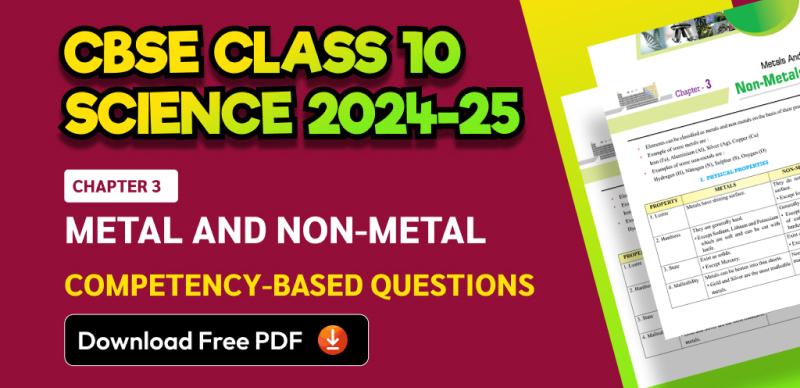
CBSE Class 10 Science 2024-25: Chapter 3 Metal and Non-metal Competency-Based Questions with Answers; Download Free PDF
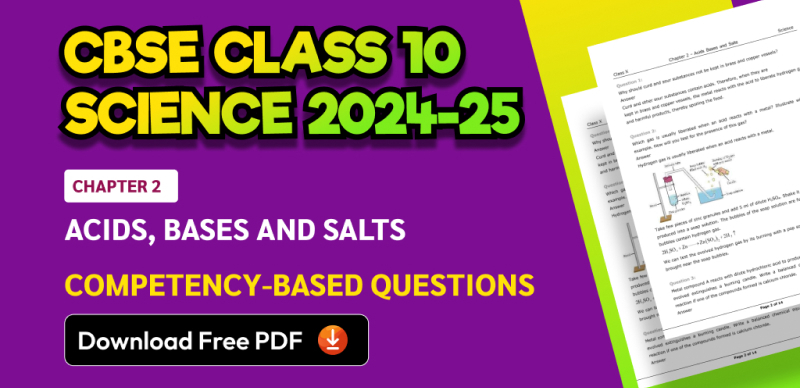
CBSE Class 10 Science 2024-25: Chapter 2 Acids, Bases and Salts Competency-Based Questions with Answers; Download Free PDF
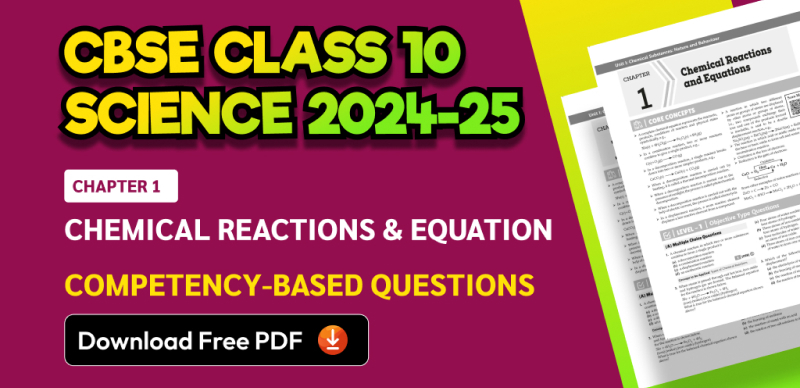
CBSE Class 10 Science 2024-25: Chapter 1 Chemical Reactions & Equation Competency-Based Questions with Answers; Download Free PDF
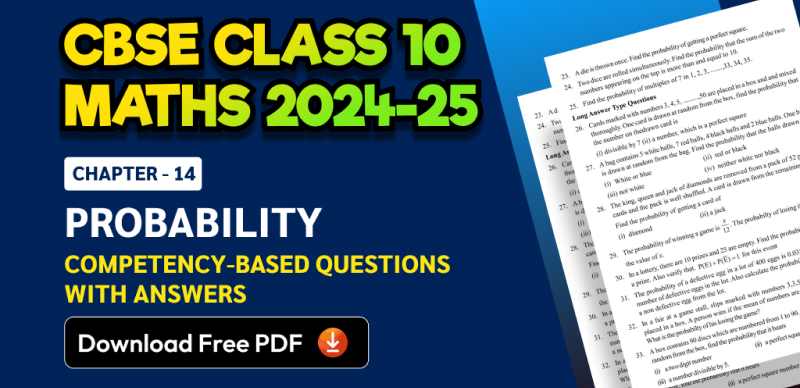
CBSE Class 10 Maths 2024-25: Chapter 14 Probability Competency-Based Questions with Answers; Download Free PDF
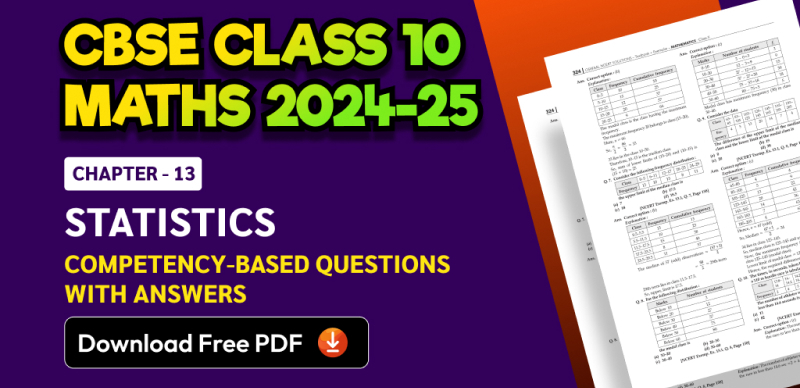
CBSE Class 10 Maths 2024-25: Chapter 13 Statistics Competency-Based Questions with Answers; Download Free PDF
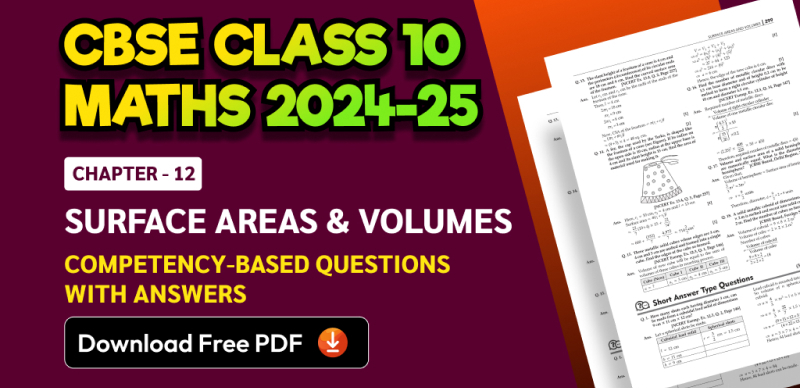
CBSE Class 10 Maths 2024-25: Chapter 12 Surface Areas and Volumes Competency-Based Questions with Answers; Download Free PDF

- NCERT Solutions for Class 12 Maths
- NCERT Solutions for Class 10 Maths
- CBSE Syllabus 2023-24
- Social Media Channels
- Login Customize Your Notification Preferences

- Second click on the toggle icon

Provide prime members with unlimited access to all study materials in PDF format.
Allow prime members to attempt MCQ tests multiple times to enhance their learning and understanding.
Provide prime users with access to exclusive PDF study materials that are not available to regular users.


CBSE 10th Standard Maths Subject Arithmetic Progressions Case Study Questions With Solution 2021
QB365 Provides the updated CASE Study Questions for Class 10 Maths, and also provide the detail solution for each and every case study questions . Case study questions are latest updated question pattern from NCERT, QB365 will helps to get more marks in Exams
QB365 - Question Bank Software
10th Standard CBSE
Final Semester - June 2015
Case Study Questions

(ii) Find the sum of common difference of the two progressions.
(iii) Find the 19 th term of the progression written by Geeta.
(iv) Find the sum of first 10 terms of the progression written by Geeta.
(v) Which term of the two progressions will have the same value?

(ii) What is the total amount saved by Anuj in 8 days?
(iii) What is the amount saved by Anuj on 30 th day?
(iv) What is the total amount saved by him in the month of June, if he starts savings from 1 st June?
(v) On which day, he save tens times as much as he saved on day-I?

(ii) The number on first card is
(iii) What is the number on the 19 th card?
(iv) What is the number on the 23 rd card?
(v) The sum of numbers on the first 15 cards is
A sequence is an ordered list of numbers. A sequence of numbers such that the difference between the consecutive terms is constant is said to be an arithmetic progression (A.P.). On the basis of above information, answer the following questions. (i) Which of the following sequence is an A.P.?
(ii) If x, y and z are in A.P., then
(iii) If a 1 a 2 , a 3 ..... , a n are in A.P., then which of the following is true?
| + k, a + k, a + k, , a + k are in A.P., where k is a constant. |
| k - a , k - a , , k - a are in A.P., where k is a constant. |
| , ka , ka ..... , ka are in A.P., where k is a constant. |
(iv) If the n th term (n > 1) of an A.P. is smaller than the first term, then nature of its common difference (d) is
(v) Which of the following is incorrect about A.P.?

(ii) What is the first term?
(iii) Which term of the A.P. is -160?
(iv) Which of the following is not a term of the given A.P.?
(v) What is the 75 th term of the A.P.?
*****************************************
Related 10th standard cbse maths materials, other 10th standard cbse materials.

CBSE 10th Social Science The Making Of A Global World Chapter Case Study Question with Answers
Cbse 10th social science nationalism in india chapter case study question with answers, cbse 10th social science the rise of nationalism in europe chapter case study question with answers.

CBSE 10th Science Metals And Non Metals Chapter Case Study Question with Answers
Cbse 10th science acids, bases and salts chapter case study question with answers, cbse 10th science chemical reactions and equations chapter case study question with answers, class 10th science - our environment case study questions and answers 2022 - 2023, class 10th science - magnetic effects of electric current case study questions and answers 2022 - 2023, class 10th science - electricity case study questions and answers 2022 - 2023, class 10th science - human eye and the colourful world case study questions and answers 2022 - 2023, class 10th science - light reflection and refraction case study questions and answers 2022 - 2023, class 10th science - heredity and evolution case study questions and answers 2022 - 2023, class 10th science - how do organisms reproduce case study questions and answers 2022 - 2023, class 10th science - life processes case study questions and answers 2022 - 2023, class 10th science - periodic classification of elements case study questions and answers 2022 - 2023, tamilnadu stateboard 10th standard cbse study materials.

Tamilnadu Stateboard 10th Standard CBSE Subjects

- Class 6 Maths
- Class 6 Science
- Class 6 Social Science
- Class 6 English
- Class 7 Maths
- Class 7 Science
- Class 7 Social Science
- Class 7 English
- Class 8 Maths
- Class 8 Science
- Class 8 Social Science
- Class 8 English
- Class 9 Maths
- Class 9 Science
- Class 9 Social Science
- Class 9 English
- Class 10 Maths
- Class 10 Science
- Class 10 Social Science
- Class 10 English
- Class 11 Maths
- Class 11 Computer Science (Python)
- Class 11 English
- Class 12 Maths
- Class 12 English
- Class 12 Economics
- Class 12 Accountancy
- Class 12 Physics
- Class 12 Chemistry
- Class 12 Biology
- Class 12 Computer Science (Python)
- Class 12 Physical Education
- GST and Accounting Course
- Excel Course
- Tally Course
- Finance and CMA Data Course
- Payroll Course
Interesting
- Learn English
- Learn Excel
- Learn Tally
- Learn GST (Goods and Services Tax)
- Learn Accounting and Finance
- GST Tax Invoice Format
- Accounts Tax Practical
- Tally Ledger List
- GSTR 2A - JSON to Excel
Are you in school ? Do you love Teachoo?
We would love to talk to you! Please fill this form so that we can contact you
You are learning...
Chapter 5 Class 10 Arithmetic Progressions
Click on any of the links below to start learning from Teachoo ...
Updated for new NCERT Book - 2024-25 Edition
Get solutions of all NCERT Questions with examples of Chapter 5 Class 10 Arithmetic Progressions (AP). Video of all questions are also available.
In this chapter, we will learn
- What is an AP - and what is First term (a) and Common Difference (d) of an Arithmetic Progression
- Finding n th term of an AP (a n )
- Finding n using a n formula
- Finding AP when some terms are given
- Finding n th term from the last term
- Finding Sum of n terms of an AP ( S n ) - both formulas
- Finding number of terms when Sum is given
- If n th term is given, finding S
- Some statement questions using a n and S n formulas, including optional exercise
Check out the answers to the exercises (including examples and optional) by clicking a link below, or learn from the concepts.
Serial order wise
Concept wise.
What's in it?
Hi, it looks like you're using AdBlock :(
Please login to view more pages. it's free :), solve all your doubts with teachoo black.
CBSE Expert
CBSE Class 10 Maths Case Study Questions PDF
Download Case Study Questions for Class 10 Mathematics to prepare for the upcoming CBSE Class 10 Final Exam. These Case Study and Passage Based questions are published by the experts of CBSE Experts for the students of CBSE Class 10 so that they can score 100% on Boards.

CBSE Class 10 Mathematics Exam 2024 will have a set of questions based on case studies in the form of MCQs. The CBSE Class 10 Mathematics Question Bank on Case Studies, provided in this article, can be very helpful to understand the new format of questions. Share this link with your friends.
Table of Contents
Chapterwise Case Study Questions for Class 10 Mathematics
Inboard exams, students will find the questions based on assertion and reasoning. Also, there will be a few questions based on case studies. In that, a paragraph will be given, and then the MCQ questions based on it will be asked.
The above Case studies for Class 10 Maths will help you to boost your scores as Case Study questions have been coming in your examinations. These CBSE Class 10 Mathematics Case Studies have been developed by experienced teachers of cbseexpert.com for the benefit of Class 10 students.
- Class 10th Science Case Study Questions
- Assertion and Reason Questions of Class 10th Science
- Assertion and Reason Questions of Class 10th Social Science
Class 10 Maths Syllabus 2024
Chapter-1 real numbers.
Starting with an introduction to real numbers, properties of real numbers, Euclid’s division lemma, fundamentals of arithmetic, Euclid’s division algorithm, revisiting irrational numbers, revisiting rational numbers and their decimal expansions followed by a bunch of problems for a thorough and better understanding.
Chapter-2 Polynomials
This chapter is quite important and marks securing topics in the syllabus. As this chapter is repeated almost every year, students find this a very easy and simple subject to understand. Topics like the geometrical meaning of the zeroes of a polynomial, the relationship between zeroes and coefficients of a polynomial, division algorithm for polynomials followed with exercises and solved examples for thorough understanding.
Chapter-3 Pair of Linear Equations in Two Variables
This chapter is very intriguing and the topics covered here are explained very clearly and perfectly using examples and exercises for each topic. Starting with the introduction, pair of linear equations in two variables, graphical method of solution of a pair of linear equations, algebraic methods of solving a pair of linear equations, substitution method, elimination method, cross-multiplication method, equations reducible to a pair of linear equations in two variables, etc are a few topics that are discussed in this chapter.
Chapter-4 Quadratic Equations
The Quadratic Equations chapter is a very important and high priority subject in terms of examination, and securing as well as the problems are very simple and easy. Problems like finding the value of X from a given equation, comparing and solving two equations to find X, Y values, proving the given equation is quadratic or not by knowing the highest power, from the given statement deriving the required quadratic equation, etc are few topics covered in this chapter and also an ample set of problems are provided for better practice purposes.

Chapter-5 Arithmetic Progressions
This chapter is another interesting and simpler topic where the problems here are mostly based on a single formula and the rest are derivations of the original one. Beginning with a basic brief introduction, definitions of arithmetic progressions, nth term of an AP, the sum of first n terms of an AP are a few important and priority topics covered under this chapter. Apart from that, there are many problems and exercises followed with each topic for good understanding.
Chapter-6 Triangles
This chapter Triangle is an interesting and easy chapter and students often like this very much and a securing unit as well. Here beginning with the introduction to triangles followed by other topics like similar figures, the similarity of triangles, criteria for similarity of triangles, areas of similar triangles, Pythagoras theorem, along with a page summary for revision purposes are discussed in this chapter with examples and exercises for practice purposes.
Chapter-7 Coordinate Geometry
Here starting with a general introduction, distance formula, section formula, area of the triangle are a few topics covered in this chapter followed with examples and exercises for better and thorough practice purposes.
Chapter-8 Introduction to Trigonometry
As trigonometry is a very important and vast subject, this topic is divided into two parts where one chapter is Introduction to Trigonometry and another part is Applications of Trigonometry. This Introduction to Trigonometry chapter is started with a general introduction, trigonometric ratios, trigonometric ratios of some specific angles, trigonometric ratios of complementary angles, trigonometric identities, etc are a few important topics covered in this chapter.
Chapter-9 Applications of Trigonometry
This chapter is the continuation of the previous chapter, where the various modeled applications are discussed here with examples and exercises for better understanding. Topics like heights and distances are covered here and at the end, a summary is provided with all the important and frequently used formulas used in this chapter for solving the problems.
Chapter-10 Circle
Beginning with the introduction to circles, tangent to a circle, several tangents from a point on a circle are some of the important topics covered in this chapter. This chapter being practical, there are an ample number of problems and solved examples for better understanding and practice purposes.
Chapter-11 Constructions
This chapter has more practical problems than theory-based definitions. Beginning with a general introduction to constructions, tools used, etc, the topics like division of a line segment, construction of tangents to a circle, and followed with few solved examples that help in solving the exercises provided after each topic.
Chapter-12 Areas related to Circles
This chapter problem is exclusively formula based wherein topics like perimeter and area of a circle- A Review, areas of sector and segment of a circle, areas of combinations of plane figures, and a page summary is provided just as a revision of the topics and formulas covered in the entire chapter and also there are many exercises and solved examples for practice purposes.
Chapter-13 Surface Areas and Volumes
Starting with the introduction, the surface area of a combination of solids, the volume of a combination of solids, conversion of solid from one shape to another, frustum of a cone, etc are to name a few topics explained in detail provided with a set of examples for a better comprehension of the concepts.
Chapter-14 Statistics
In this chapter starting with an introduction, topics like mean of grouped data, mode of grouped data, a median of grouped, graphical representation of cumulative frequency distribution are explained in detail with exercises for practice purposes. This chapter being a simple and easy subject, securing the marks is not difficult for students.
Chapter-15 Probability
Probability is another simple and important chapter in examination point of view and as seeking knowledge purposes as well. Beginning with an introduction to probability, an important topic called A theoretical approach is explained here. Since this chapter is one of the smallest in the syllabus and problems are also quite easy, students often like this chapter
Leave a Comment Cancel reply
Save my name, email, and website in this browser for the next time I comment.
Download India's best Exam Preparation App Now.
Key Features
- Revision Notes
- Important Questions
- Previous Years Questions
- Case-Based Questions
- Assertion and Reason Questions
No thanks, I’m not interested!
Class 10 Maths Chapter 5 Case Based Questions - Arithmetic Progressions
| 1 Crore+ students have signed up on EduRev. Have you? |
Case Study - 1
Your elder brother wants to buy a car and plans to take loan from a bank for his car. He repays his total loan of Rs 1,18,000 by paying every month starting with the first instalment of Rs 1000. If he increases the instalment by Rs 100 every month, answer the following:

Case Study - 2
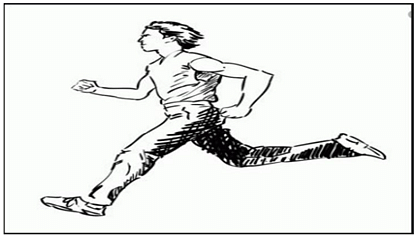
Case Study - 3

Based on the above information, answer the following questions:
Q1: Find the production during first year. Ans: We are given that the production of TV sets in the factory is increasing uniformly. This means that we can apply the formula of an arithmetic progression, where the nth term (a_n) is given by a + (n-1)d. Here, 'a' is the first term, 'n' is the term number, and 'd' is the common difference. We know that the 6th year production (a_6) is 16000 and the 9th year production (a_9) is 22600. We can subtract the 6th year production from the 9th year to find the total increase over 3 years, which is 6600. This means that the common difference ('d') is 6600/3 = 2200 sets per year. Substituting the values into the nth term formula: 16000 = a + (6-1)*2200 16000 = a + 11000 => a = 16000 - 11000 => a = 5000 So, the production during the first year was 5000 sets. Q2: Find the production during 8th year. Ans: We can use the nth term formula again to find the production in the 8th year. a_8 = a + (8-1)*d = 5000 + 7*2200 = 5000 + 15400 = 20400 So, the production during the 8th year was 20400 sets. Q3: Find the production during first 3 years. Ans: To find the total production over the first 3 years, we sum the production over each year. In an arithmetic progression, the sum of the first n terms (S_n) is given by n/2 * (2a + (n-1)d). S_3 = 3/2 * (2*5000 + (3-1)*2200) = 1.5 * (10000 + 4400) = 1.5 * 14400 = 21600 So, the total production during the first 3 years was 21600 sets. Q4: In which year, the production is Rs 29,200. Ans: To find the year when the production was 29200, we can use the nth term formula and solve for n. 29200 = 5000 + (n-1)2200 => 24200 = (n-1)2200 => n-1 = 24200/2200 => n-1 = 11 => n = 12 So, the production was 29200 sets in the 12th year. Q5: Find the difference of the production during 7th year and 4th year. Ans: We can find the production in the 7th and 4th years using the nth term formula, and then subtract the two. a_7 = 5000 + 6*2200 = 18200 a_4 = 5000 + 3*2200 = 11600 Difference = a_7 - a_4 = 18200 - 11600 = 6600 So, the difference in production between the 7th and 4th years was 6600 sets.
Top Courses for Class 10
| Last updated |
Semester Notes
Mock tests for examination, viva questions, sample paper, important questions, past year papers, objective type questions, previous year questions with solutions, practice quizzes, study material, extra questions, video lectures, shortcuts and tricks.

Case Based Questions: Arithmetic Progressions Free PDF Download
Importance of case based questions: arithmetic progressions, case based questions: arithmetic progressions notes, case based questions: arithmetic progressions class 10, study case based questions: arithmetic progressions on the app.
| cation olution |
| Join the 10M+ students on EduRev |
Welcome Back
Create your account for free.

Forgot Password
Change country.
CBSE Case Study Questions for Class 10 Maths Arithmetic Progressions Free PDF
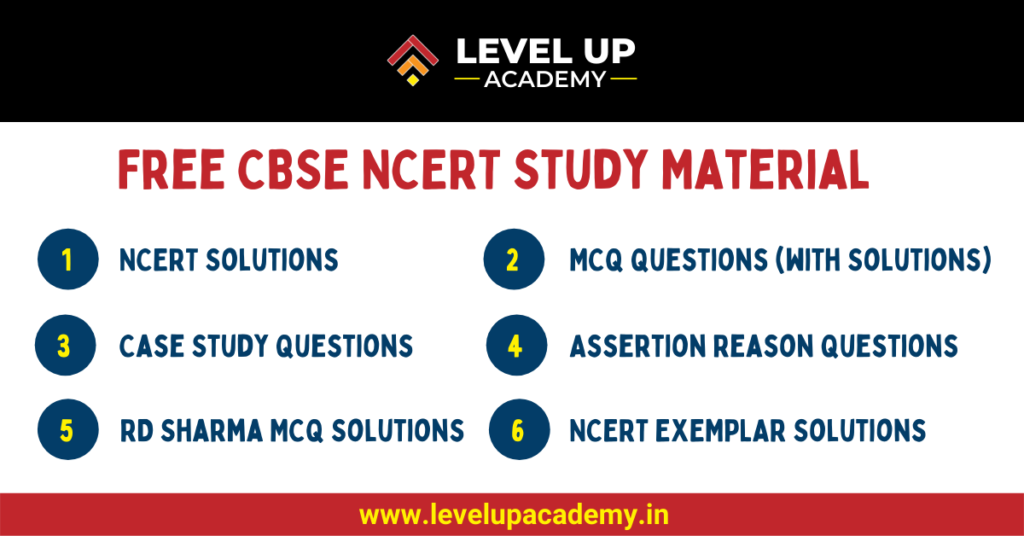
Mere Bacchon, you must practice the CBSE Case Study Questions Class 10 Maths Arithmetic Progressions in order to fully complete your preparation . They are very very important from exam point of view. These tricky Case Study Based Questions can act as a villain in your heroic exams!
I have made sure the questions (along with the solutions) prepare you fully for the upcoming exams. To download the latest CBSE Case Study Questions , just click ‘ Download PDF ’.
CBSE Case Study Questions for Class 10 Maths Arithmetic Progressions PDF
Checkout our case study questions for other chapters.
- Chapter 3: Pair of Linear Equations in Two Variables Case Study Questions
- Chapter 4: Quadratic Equation Case Study Questions
- Chapter 6: Triangles Case Study Questions
- Chapter 7: Coordinate Geometry Case Study Questions
How should I study for my upcoming exams?
First, learn to sit for at least 2 hours at a stretch
Solve every question of NCERT by hand, without looking at the solution.
Solve NCERT Exemplar (if available)
Sit through chapter wise FULLY INVIGILATED TESTS
Practice MCQ Questions (Very Important)
Practice Assertion Reason & Case Study Based Questions
Sit through FULLY INVIGILATED TESTS involving MCQs. Assertion reason & Case Study Based Questions
After Completing everything mentioned above, Sit for atleast 6 full syllabus TESTS.
Comments are closed.
Contact Form
Privacy Policy
- Class 10 Maths
- Chapter 5: Arithmetic Progressions

Important Questions for Class 10 Maths Chapter 5: Arithmetic Progression
Class 10 Maths important questions for Chapter 5, Arithmetic Progression , are provided for students to prepare for board exams 2022-2023. The questions here are based on the NCERT book and are as per the CBSE syllabus . These important questions are created after in-depth research on the exam pattern, previous year papers, exam trends and latest released sample papers of 2022-23. By solving these questions, students can score high marks in the Maths exam. They can cross-check their answers with the solutions provided here. So, students are advised to solve these questions and practise them well. It will boost their confidence level and give them good practice.

Arithmetic progression deals with the concept of a sequence that appears in a pattern, such that there is a common difference between each term of the given series. In this chapter, you will come across finding the nth term of AP, the sum of n terms of AP using the relevant formulas.
Check important questions for all the chapters for Class 10 Maths here.
Students can practice all the questions provided at the end of this page to improve their problem-solving skills on arithmetic progression. These additional questions cover the variety of questions that can be asked in the Class 10 Maths board exam 2022-23.

Important Questions For Class 10 Chapter 5 With Solutions
Q.1: Write first four terms of the AP when the first term a and the common difference d are given as follows:
(i) a = 10, d = 10 (ii) a = -2, d = 0 (iii) a = 4, d = – 3
(i) a = 10, d = 10
Let an AP be a 1 , a 2 , a 3 , a 4 , a 5 … a 1 = a = 10 a 2 = a 1 + d = 10 + 10 = 20 a 3 = a 2 + d = 20 + 10 = 30 a 4 = a 3 + d = 30 + 10 = 40 a 5 = a 4 + d = 40 + 10 = 50 And so on…
Therefore, the AP will be 10, 20, 30, 40, 50 …
The first four terms of this AP will be 10, 20, 30, and 40.
(ii) a = -2, d = 0
Let an AP be a 1 , a 2 , a 3 , a 4 , a 5 …
a 1 = a = -2 a 2 = a 1 + d = -2 + 0 = -2 a 3 = a 2 + d = -2 + 0 = -2 a 4 = a 3 + d = -2 + 0 = -2
Therefore, the AP will be -2, -2, -2, -2 …
The first four terms of this AP will be -2, -2, -2 and -2.
(iii) a = 4, d = -3
Let an AP be a 1 , a 2 , a 3 , a 4 , a 5 … a 1 = a = 4 a 2 = a 1 + d = 4 – 3 = 1 a 3 = a 2 + d = 1 – 3 = -2 a 4 = a 3 + d = -2 – 3 = -5
Therefore, the AP will be 4, 1, -2, -5 …
And, the first four terms of this AP will be 4, 1, -2 and -5.
Q.2: Which term of the AP: 21, 18, 15, . . . is – 81? Also, is any term 0? Give reason for your answer.
Given AP: 21, 18, 15,…
Here, a = 21,
d = 18 – 21 = –3
Let nth term of the given AP is -81.
So, a n = –81 As we know,
a n = a + ( n – 1) d Thus,
– 81 = 21 + (n – 1)(– 3) – 81 = 24 – 3n – 105 = – 3n So, n = 35
Therefore, the 35th term of the given AP is – 81.
Next, we want to know if there is any n for which a n = 0.
If such an n is there, then;
21 + (n – 1) (–3) = 0
⇒ 3(n – 1) = 21
⇒ n – 1 = 7
Therefore, the eighth term is 0.
Q.3: Check whether – 150 is a term of the AP: 11, 8, 5, 2 . . .
Given AP: 11, 8, 5, 2, …
First term, a = 11
Common difference, d = a 2 − a 1 = 8 − 11 = −3
Let −150 be the nth term of this AP.
As we know, for an AP,
a n = a + (n − 1) d
-150 = 11 + (n – 1)(-3)
-150 = 11 – 3n + 3
⇒ -164 = -3n
⇒ n = 164/3
Clearly, n is not an integer but a fraction.
Therefore, – 150 is not a term of the given AP.
Q.4: If the 3rd and the 9th terms of an AP are 4 and -8, respectively, then which term of this AP is zero.
Given that,
3rd term, a 3 = 4 9th term, a 9 = −8
We know that, the nth term of AP is; a n = a + (n − 1) d
Therefore, a 3 = a + (3 − 1) d 4 = a + 2d ……………………………………… (i)
a 9 = a + (9 − 1) d −8 = a + 8d ………………………………………………… (ii)
On subtracting equation (i) from (ii), we get; −12 = 6d d = −2
Substituting d = -2 in equation (i), we get; 4 = a + 2 (−2) 4 = a − 4 a = 8
Let nth term of this AP be zero. a n = a + (n − 1) d 0 = 8 + (n − 1) (−2) 0 = 8 − 2n + 2 2n = 10 ⇒ n = 5
Hence, 5th term of the given AP is 0.
Q.5: Which term of the AP 3, 15, 27, 39, … will be 132 more than its 54th term?
Given AP is: 3, 15, 27, 39, … First term, a = 3 Common difference, d = a 2 − a 1 = 15 − 3 = 12
We know that, a n = a + (n − 1) d
a 54 = a + (54 − 1) d = 3 + (53) (12) = 3 + 636 a 54 = 639
We have to find the term of this AP.which is 132 more than a 54 , i.e. 771. Let nth term be 771. a n = a + (n − 1) d 771 = 3 + (n − 1) 12 768 = (n − 1) 12 ⇒ (n − 1) = 64 ⇒ n = 65
Therefore, the 65th term is 132 more than the 54th term of the given AP.
Alternate Method:
Let nth term be 132 more than 54th term. n = 54 + (132/12)
= 65th term
Q. 6: How many multiples of 4 lie between 10 and 250?
The first multiple of 4 that is greater than 10 is 12.
The next multiple will be 16. Therefore, the series formed as;
12, 16, 20, 24, …
All these are divisible by 4 and thus, all these are terms of an AP with the first term as 12 and the common difference as 4.
When we divide 250 by 4, the remainder will be 2. Therefore, 250 − 2 = 248 is divisible by 4.
The series is as follows. 12, 16, 20, 24, …, 248
Let 248 be the nth term of this AP. First term, a = 12 Common difference, d = 4 a n = 248
As we know, a n = a + (n – 1) d 248 = 12 + (n – 1) × 4 ⇒ 236/4 = n – 1 ⇒ 59 = n – 1 ⇒ n = 60
Therefore, there are 60 multiples of 4 between 10 and 250.
Q.7: The sum of 4th and 8th terms of an AP is 24 and the sum of the 6th and 10th terms is 44. Find the first three terms of the AP.
We know, the nth term of the AP is; a n = a + (n − 1) d a 4 = a + (4 − 1) d a 4 = a + 3d
Thus, we can write, a 8 = a + 7d a 6 = a + 5d a 10 = a + 9d
Given in the question;
a 4 + a 8 = 24 a + 3d + a + 7d = 24 2a + 10d = 24 a + 5d = 12 …………………………………………………… (i) a 6 + a 10 = 44 a + 5d + a + 9d = 44 2a + 14d = 44 a + 7d = 22 …………………………………….. (ii)
On subtracting equation (i) from (ii), we get, 2d = 22 − 12 2d = 10 d = 5
From equation (i), we get,
a + 5d = 12 a + 5 (5) = 12 a + 25 = 12 a = −13 a 2 = a + d = −13 + 5 = −8 a 3 = a2 + d = −8 + 5 = −3
Therefore, the first three terms of this AP are −13, −8, and −3.
Q.8: Ramkali saved Rs 5 in the first week of a year and then increased her weekly saving by Rs 1.75. If in the nth week, her weekly savings become Rs 20.75, find n.
Given that, Ramkali saved Rs.5 in the first week and then started increasing her savings each week by Rs.1.75.
First term, a = 5 and common difference, d = 1.75
Also given, a n = 20.75 Find, n = ?
As we know, by the nth term formula, a n = a + (n − 1) d
Therefore, 20.75 = 5 + (n – 1) × 1.75
15.75 = (n – 1) × 1.75
(n – 1) = 15.75/1.75
= 9 ⇒ n = 10 Hence, n is 10.
Q.9: How many terms of the AP : 24, 21, 18, . . . must be taken so that their sum is 78?
Given AP: 24, 21, 18,…
Here, a = 24, d = 21 – 24 = –3, S n = 78. We need to find n. We know that;
156 = 51n – 3n 2
3n 2 – 51n + 156 = 0
n 2 – 17n + 52 = 0
n 2 – 13n – 4n + 52 = 0
n(n – 13) – 4(n – 13) = 0
(n – 4) (n – 13) = 0
n = 4 or 13 Both values of n are admissible. So, the number of terms is either 4 or 13.
Q. 10: The first term of an AP is 5, the last term is 45 and the sum is 400. Find the number of terms and the common difference.
Given that, first term, a = 5 last term, l = 45 Sum of the AP, S n = 400
As we know, the sum of AP formula is; S n = n/2 (a + l) 400 = n/2 (5 + 45)
400 = n/2 (50) Number of terms, n = 16
As we know, the last term of AP can be written as; Last term, l = a + (n − 1) d 45 = 5 + (16 − 1) d 40 = 15d Therefore, the Common difference is d = 40/15 = 8/3.
Q.11: Find the sum of the first 22 terms of an AP in which d = 7 and 22 nd term is 149.
Given, Common difference, d = 7 22 nd term, a 22 = 149 To find: Sum of first 22 term, S 22
By the formula of nth term, we know; a n = a + (n − 1)d a 22 = a + (22 − 1)d 149 = a + 21 × 7 149 = a + 147 a = 2 = First term
Sum of the first n terms is given by the formula; S n = n/2 (a + a n ) S 22 = 22/2 (2 + 149) = 11 × 151 = 1661
Q.12: If the sum of the first n terms of an AP is 4n − n 2 , what is the first term (that is S 1 )? What is the sum of the first two terms? What is the second term? Similarly find the 3rd, the 10th and the nth terms.
Given that, S n = 4n − n 2 First term, a = S 1 = 4(1) − (1) 2 = 4 − 1 = 3 Sum of first two terms = S 2 = 4(2) − (2) 2 = 8 − 4 = 4 Second term, a 2 = S 2 − S 1 = 4 − 3 = 1 Common difference, d = a 2 − a = 1 − 3 = −2
nth term is given by, a n = a + (n − 1)d = 3 + (n − 1) (−2)
= 3 − 2n + 2 = 5 − 2n
Therefore, a 3 = 5 − 2(3) = 5 − 6 = −1 a 10 = 5 − 2(10) = 5 − 20 = −15
Hence, the sum of first two terms is 4.
The second term is 1.
The 3rd, 10th, and nth terms are −1, −15, and 5 − 2n respectively.
Q.13: A sum of Rs 700 is to be used to give seven cash prizes to students of a school for their overall academic performance. If each prize is Rs 20 less than its preceding prize, find the value of each of the prizes.
Let the cost of 1st prize be Rs.P. Cost of 2nd prize = Rs.P − 20 And cost of 3rd prize = Rs.P − 40 We can see that the cost of these prizes is in the form of AP, having a common difference as −20 and first term as P. Thus, a = P and d = −20
Given that, S 7 = 700
By the formula of sum of nth term, we know,
7/2 [2a + (7 – 1)d] = 700
a + 3(−20) = 100 a − 60 = 100 a = 160 Therefore, the value of each of the prizes was Rs 160, Rs 140, Rs 120, Rs 100, Rs 80, Rs 60, and Rs 40.
Q.14: The sum of the third and the seventh terms of an AP is 6 and their product is 8. Find the sum of the first sixteen terms of the AP.
Solution: From the given statements, we can write,
a 3 + a 7 = 6 …………………………….(i)
a 3 × a 7 = 8 ……………………………..(ii)
By the nth term formula, a n = a + (n − 1)d
Third term, a 3 = a + (3 -1)d
a 3 = a + 2d………………………………(iii)
And Seventh term, a 7 = a + (7 -1)d
a 7 = a + 6d ………………………………..(iv)
From equation (iii) and (iv), putting in equation(i), we get,
a + 2d + a + 6d = 6
2a + 8d = 6
a = 3 – 4d …………………………………(v)
Again putting the eq. (iii) and (iv), in eq. (ii), we get,
(a + 2d) × (a + 6d) = 8
Putting the value of a from equation (v), we get,
(3 – 4d + 2d) × (3 – 4d + 6d) = 8
(3 – 2d) × (3 + 2d) = 8
3 2 – 2d 2 = 8
9 – 4d 2 = 8
d = 1/2 or -1/2
Now, by putting both the values of d, we get,
a = 3 – 4d = 3 – 4(1/2) = 3 – 2 = 1, when d = ½
a = 3 – 4d = 3 – 4(-1/2) = 3+2 = 5, when d = -1/2
We know, the sum of nth term of AP is;
So, when a = 1 and d=1/2
Then, the sum of first 16 terms are;
S 16 = 16/2 [2 + (16 – 1)(1/2)] = 8[2 + (15/2)] = 76
And when a = 5 and d = -1/2
Then, the sum of first 16 terms is;
S 16 = 16/2 [2(5) + (16 – 1)(-1/2)] = 8(5/2) = 20
Q.15: The houses of a row are numbered consecutively from 1 to 49. Show that there is a value of x such that the sum of the numbers of the houses preceding the house numbered x is equal to the sum of the numbers of the houses following it. Find this value of x. [Hint : S x-1 = S 49 – S x ]
Solution: Given,
Row houses are numbers from 1, 2, 3, 4, 5…….49.
Thus, we can see the houses numbered in a row are in the form of AP.
First term, a = 1
Common difference, d = 1
Let’ represent the number of the house as;
Sum of preceding the numbers of x = sum of following numbers of x
That is 1 + 2 + 3 + …… + ( x – 1) = ( x + 1) + ( x + 2) …… + 49
=> (x – 1)x = (49 – x)(x + 50)
=> x² – x = 49x + 2450 – x² – 50x
=> x² – x = 2450 – x² – x
=> 2x² = 2450
=> x² = 1225
Class 10 Maths Chapter 5 Arithmetic Progression Questions for Practice
- Show that (a – b)², (a² + b²) and (a + b)² are in AP.
- Find the common difference of the Arithmetic Progression (AP) (1/a), (3 – a)/3a, (3 – 2a)/3a,… (a ≠ 0)
- Which term of the Arithmetic Progression -7, -12, -17, -22,… will be -82? Is -100 any term of the AP? Give a reason for your answer.
- How many terms of the Arithmetic Progression 45, 39, 33,… must be taken so that their sum is 180? Explain the double answer.
- In an AP, if the common difference (d) = -4, and the seventh term (a 7 ) is 4, then find the first term.
- The sum of four consecutive numbers in an AP is 32 and the ratio of the product of the first and the last term to the product of two middle terms is 7 : 15. Find the numbers.
- What is the common difference of an A.P. in which a 21 – a 7 = 84?
- Which term of the progression 20, 19 ¼, 18 ½, 17 ¾,… is the first negative term?
- If the ratio of the sum of the first n terms of two APs is (7n + 1) : (4n + 27), then find the ratio of their 9th terms.
- The 4th term of an AP is zero. Prove that the 25th term of the AP is three times its 11th term.
| MATHS Related Links | |
Leave a Comment Cancel reply
Your Mobile number and Email id will not be published. Required fields are marked *
Request OTP on Voice Call
Post My Comment
Very nice app loving byjus
Please send me extra questions in all sub state syllabus in sslc
Please visit: https://byjus.com/maths/important-questions-class-10-maths/ https://byjus.com/maths/class-10-maths-mcqs/
Very niceVery useful.
It is very useful😊
Thanku these question helps me lot
Nice questions for practice
Thanks for the worksheet it is too helpful
THANK YOU SO MUCH FOR THIS WORKSHEET
I want science PDF
can i get some more questions
it was very useful to me
Thank you Teacher for work sheet
Thank you for the question these are nice for annual practice
Very useful. Thank you Byjus 😇🙋
These questions were very useful. Thank you Byjus😊😇👍
Tq soo much sir/madam for giving such a good difficult question and I except more such questions from u
Thankyou for these questions helpful for board exam
These questions were very useful thank you byjus you are really going great
This is a very important question for exam Thank you byjus
Register with BYJU'S & Download Free PDFs
Register with byju's & watch live videos.

IMAGES
VIDEO
COMMENTS
CBSE Class 10 Case Study Questions for Maths Chapter 5 - Arithmetic Progression are available here with answers. All the questions have been published by the CBSE board.
Class 10 Maths Chapter 5 Case Study Questions have been prepared for the latest exam pattern. You can check your knowledge by solving case study-based questions for Class 10 Maths Chapter 5 Arithmetic Progressions
The case study on Arithmetic Progressions Class 10 Maths with solutions in PDF helps students tackle questions that appear confusing or difficult to answer. The answers to the Arithmetic Progressions case study questions are very easy to grasp from the PDF - download links are given on this page.
CBSE Class 10 Maths Case Study : We have provided the PDF File of CBSE Class 10 Maths case study based Questions, MCQs, Assertion with Resion and solutions. Download CBSE Sample Paper 2024-25 for class 12th to 8th
CBSE 10th Standard Maths Subject Arithmetic Progressions Case Study Questions With Solution 2021. In a class the teacher asks every student to write an example of A.P. Two friends Geeta and Madhuri writes their progressions as -5, -2, 1,4, ... and 187, 184, 181, .... respectively.
Updated for new NCERT Book - 2024-25 Edition. Get solutions of all NCERT Questions with examples of Chapter 5 Class 10 Arithmetic Progressions (AP). Video of all questions are also available. In this chapter, we will learn. What is an AP - and what is First term (a) and Common Difference (d) of an Arithmetic Progression.
Download Case Study Questions for Class 10 Mathematics to prepare for the upcoming CBSE Class 10 Final Exam. These Case Study and Passage Based questions are published by the experts of CBSE Experts for the students of CBSE Class 10 so that they can score 100% on Boards.
Ans: (a) Explanation: The problem is a case of an arithmetic progression (AP) where the first term (a) is Rs 1000 and the common difference (d) is Rs 100. In an AP, the nth term is given by the formula a + (n-1)d. We can use this formula to find the amount paid in the 30th installment.
These Case Study Questions for Class 10 Maths Arithmetic Progressions are latest, comprehensive, confidence inspiring, with easy to understand explanation.
The 4th term of an AP is zero. Prove that the 25th term of the AP is three times its 11th term. Important Questions for Class 10 Maths Chapter 5 Arithmetic Progressions are available with solutions here. Practice extra questions with BYJU'S and score good marks in CBSE exam 2022-23.